A revolution never happens alone: at the same time as the TONEX solution from IK Multimedia settles in the guitar player landscape (see my review here), we are witnessing the beginning and the rise of an open-source – and free – solution: the Neural Amp Modeler (or NAM), developed by Steven Atkinson and a small group of contributors. Like Kemper or TONEX, NAM allows you to capture amps, pedals or complete rigs and build a model. Small review of the Neural Amp Modeler, in the version available at the time of writing this article: version 0.7.3.
Introduction
NAM is a software-only solution based on Machine Learning (ML) algorithms to produce and use complete amp, pedal and rig profiles…. Although NAM is labeled “BETA”, the application has already aroused the enthusiasm of a large community of guitarists: the quality of the rendering is impressive and very good profiles are starting to be available… The Facebook group has already aggregated more than 7,500 people and a community website allows many profiles to be shared (more details a little further down in this article). Development is still ongoing: it’s quite a unique project in the world of music, due to its open source nature, its quality, the size of the community it has started to attract and the collaborative workings of the development of the solution….
NAM is hosted on Github and is available for free download: the plugin is available at https://github.com/sdatkinson/NeuralAmpModelerPlugin. You can download built versions of the plugin by clicking on the “Release” links on the right of the page:

As you can see, the builds are available for Windows (10 and above) and Mac OS (10.15 and above). Another repository offers a Linux version (that I did not test). You can also start a build yourself, but you will probably need quite strong skills.
Note that the NAM solution includes two modules: one allows you to create models (mainly using command line), the other allows you to use the models: this review is dedicated to this “player” module, and more particularly its plug-in version.
The installation brings two components on your PC or Mac: a standalone version of NAM and a plugin version, which you can load into your DAW. Just like with the TONEX, you will therefore be able to re-amp directly in the DAW, using the models available, or perform live practice and playing.
A word about NAM models: like the TONEX, the Kemper or the Quad Cortex, the models are snapshots: they model an amp or a rig in a given configuration, and therefore they remain relatively “static”. As for these other solutions, you can adjust the gain and the tone stack, but you act on the snapshot, so there will be limitations. As explained in the TONEX review, users will compensate by using different profiles of the same gear : for example one or more low-gain, mid-gain profiles, profiles with scooped mids,…..
Note that NAM -today- cannot be considered as a “product”: there is no marketing structure and promotion and support are provided by the community. It is an open-source solution, made available for free, which you can use as a guitarist…. but also – if this is your domain and if you are interested – as a source to learn about the Machine Learning technology in the audio and musical world….
To learn more about the genesis of NAM and the philosophy of its main creator, you can consult this Tone Junkie interview with Steven Atkinson:
NAM : plug …. and … play !!!
I was able to test the NAM plugin on MacOS and on Windows. In both cases, the installation is quick and simple. It is provided by a small installer. The Mac package is unsigned, so you will need to force/allow the installer package to run.
The standalone application and the plugin look like this:
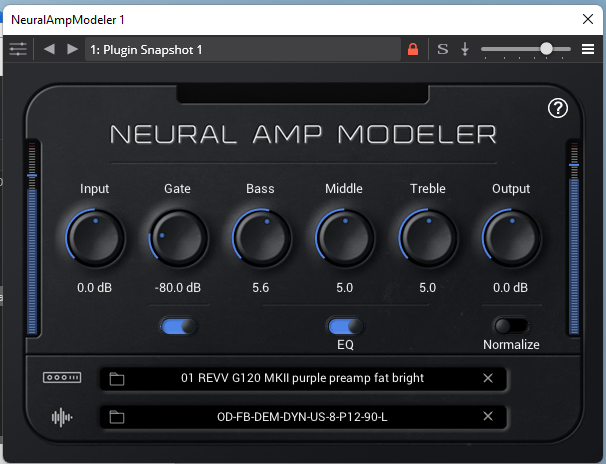
The plugin is quite simple and very light: a reduced set of parameters, a NAM profile and an IR … and here we go….
The plugin presents the following controls:
- Input: input level, acts as a gain control
- Gate: sets the threshold of the integrated noise gate (on/off button of the noise gate below)
- Bass, Middle, Treble: a classic tone stack, very effective (disengageable via the on/off button below)
- Output: the output volume of the plugin
- Normalize: automatic adjustment of the output level
The two areas at the bottom of the plugin allow you to load NAM models (which come in the form of files with .nam extension, which weigh around 300-400 KB for an amp, and 65 KB approximately for a pedal) and an IR. The IR can be bypassed : it is useful if you want to chain the NAM with a dedicated IR loader plugin (NADIR or Wall-of-sound for example).
You can therefore consider -just as with TONEX- building a chain of plugins in your STAN or your plugin host.
For example :
- A NAM instance of pedal (overdrive)
- A NAM instance of an amp
- Your favorite IR loader
- Your favorite delay effect
- Your reverb…
- …etc…
And nothing prevents you from mixing analog and digital by using for example a real overdrive pedal between your guitar and your sound card, I tested and it works very well (see gain adjustment below).
Using the standalone app is still possible and it’s a good way to easily test the NAM without the need for a DAW, but you may run out of options quite quickly: a single model, no low-cut/hi-cut on IR, no chaining to other effects…etc.
In standalone mode, I had no configuration problems on OSX with my main sound card (a rather high-end card in thunderbolt, with several inputs). On the other hand, the small Hotone Jogg interface that I tested under OSX and Windows was not usable with standalone NAM, its single input clearly posing a problem for the NAM configuration interface. On the other hand, the Jogg was fully exploitable with Logic Pro + NAM or Cantabile Light + NAM under Windows.
Getting NAM models
Two places for getting models at this point:
- A GitHub repository that includes models made by people participating in the Facebook group: https://github.com/pelennor2170/NAM_models
- A site dedicated to model sharing: https://tonehunt.org/
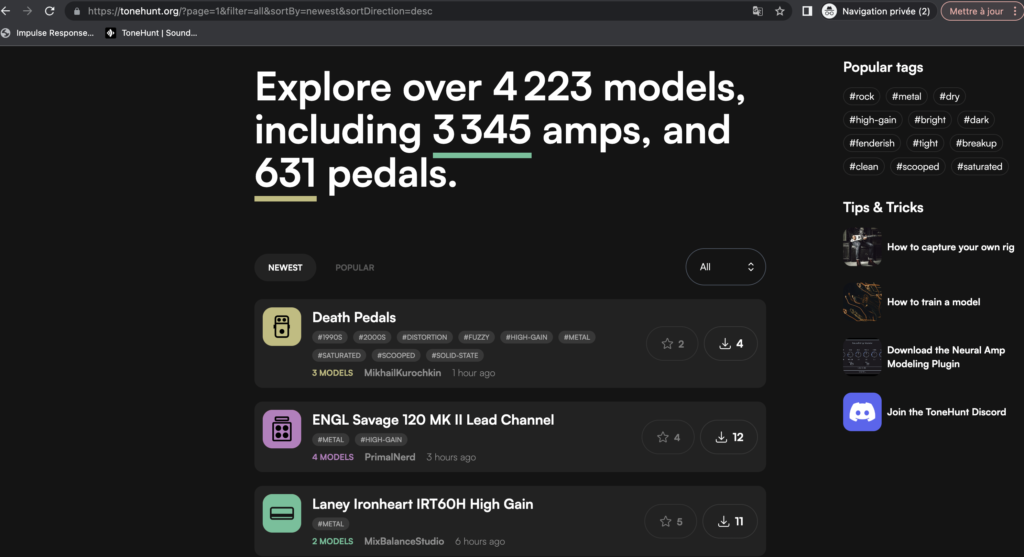

On Tonehunt.org, the majority of downloads come in the form of .zip files, containing 1 or more models. You will find Mesa, Fender, Marshall, Engl, Driftwood, Randall, etc. amp models, overdrive pedals, complete rigs… but also some more exotic models such as a Neve 1073 or even a BBE Sonic Maximizer….
4223 models were available on 05/22/2023.
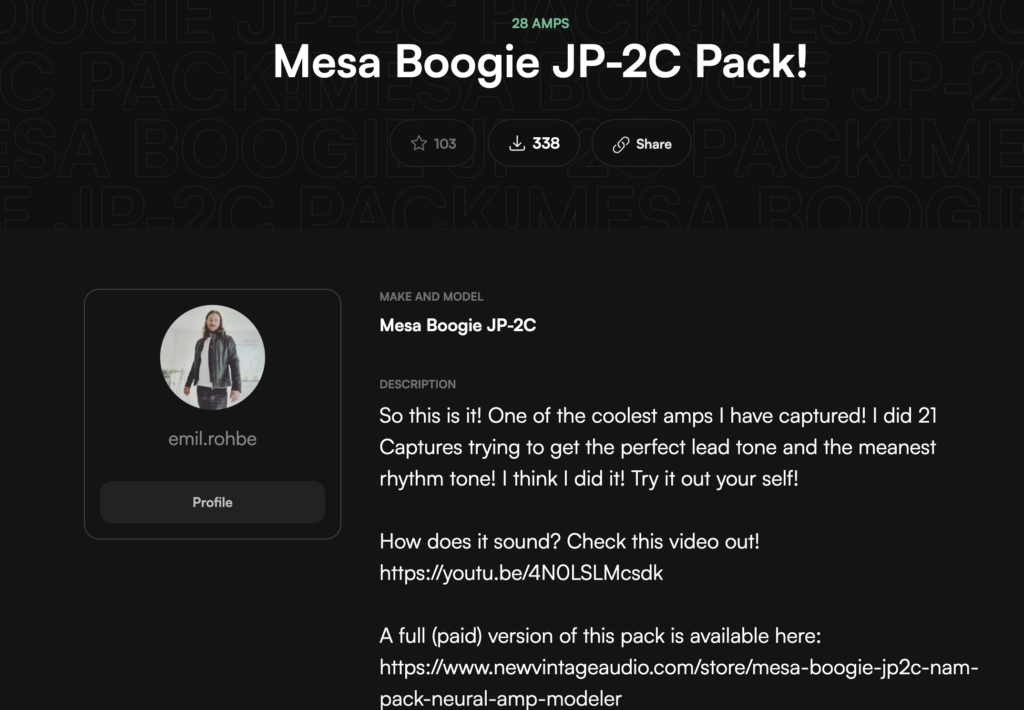
The tone
The results are truly amazing and there are already many simply excellent profiles. I was able to test models from Mesa, Marshall, Engl, Orange, Revv, from clean to high gain, with DI models (requiring association with an IR) and also a few complete rigs: some models are really very very good, the distortion being well reproduced, with good playing sensations (volume of the guitar, reaction to the attack, etc.).
A first series of demos in a nod to TONEX with a few amp models and Overdriven.fr IRs (mainly Fatboy Demon and an E112 G1265). Tracks starting with SparkTC_Mid or TS9 use two NAM instances: the first instance being the overdrive model loaded in a NAM instance placed before the NAM amp instance. The two examples of Fender clean use an additional compressor and limiter (FabFilter).
The only point that may be a little bit trickier is adjusting the gain, which can make a lot of difference in the rendering of the model. Unlike the TONEX, there is no gain control separate from the input level: the volume of your input signal determines the level of the signal and how it combines with the model. But the two meters with their clipping indicators will allow you to perform fine adjustment of your levels… I was able to test the NAM by stacking two instances with pedal and amp models, and I also used real overdrive pedals with my sound card: in both cases, I was able to obtain excellent results.
Some videos present a NAM / TONEX / Kemper / Quad Cortex comparison and place the NAM in the lead, in terms of fidelity compared to the original…. The NAM in the test carried out by Léo Gibson is -roughly speaking- equal with TONEX:
CPU load and latency
I did not measure latency, but I did not find it annoying when using the plugin while playing live (with sound cards reported by my DAW or the plugin host to be between 5 and 8 ms of latency). On the CPU consumption side, I did not observe high consumption on a recent Mac and I was able to observe usage level of around 10 to 20% of CPU on a micro PC equipped with an N95 Alder Lake (1.7 GHZ base, which “goes up” to 3.4 GHZ) for two instances of the NAM under Cantabile Light (Cantabile reporting a 10 to 15% CPU load).
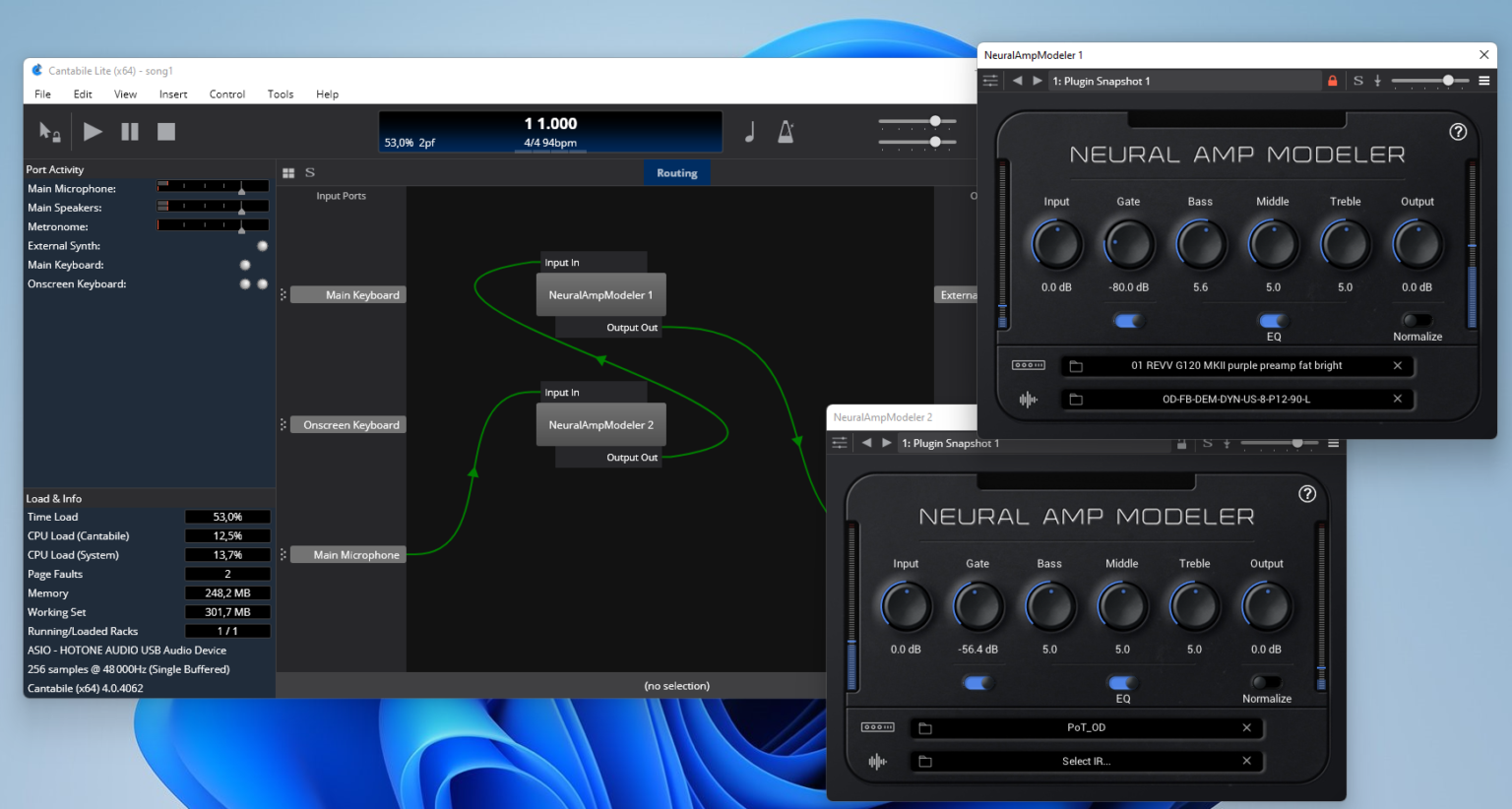
On the N95 micro-PC with a Hotone Jogg set to 48 kHz/256 samples, when Cantabile and NAM are the only ones to be launched (2 NAM instances in series), Cantabile gives me a time-load (processing time of the audio buffer) within a 50%-75% range. Note: in another fairly long test session (I was literally stuck playing on a REVV 120 Purple profile 🙂 ), in the same configuration of the micro-PC , Cantabile reported a time-load of 90-105 -110%: however, I did not encounter a single drop-out/crack during several hours of testing and the system proved to be remarkably stable…
For information, in this micro-PC/Jogg configuration, the latency calculated by Cantabile is 5.33 ms.
Conclusion
NAM offers guitarists a potentially unlimited sound palette, with an excellent level of precision when reproducing the captured models. Being free, it democratizes access to a wide range of quality sounds – even if users will remain dependent on the quality of the models captured –: a small PC and an entry-level sound card are sufficient to get great results. It does not currently have the same level of sophistication as the TONEX product(s), nor the same ease of use when it comes to capturing models, but this level of quality is a real tour de force and it already has an impressive community of supporters…
We bet that the NAM project will evolve a lot and will certainly complement and enrich itself over time…
Hats off to Steve Atkinson and the NAM contributors! And a big thank you to this team!
Change log
- May 25, 2023 : post creation
- May 27, 2023 : edits
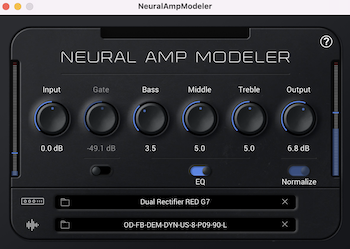
2023-05-26 at 21:01
Nice review of a truly excellent open source solution.